|
To Part One
To Part Two
August 4-9 - Windrider 17 Tri - ONWARD
“It has been real. It has been fun.
But it hasn’t been real fun yet.” - Rick
DAY THREE: The wind continued to blow hard from
the west. David got busy spreading gear out to dry while Rick
focused on getting his motor resuscitated. We all got to know
the Gaffney family better. Brian and his wife Heather and young
daughters Erin and Sophie. Brian provided Rick with some clean
gas, we visited the lighthouse a number of times, and got to go
up in the tower and watch the sunset at the end of the day. Brian
was one of six brothers. His dad had secured the lease for the
lighthouse in the 70’s. The Gaffney families each took a
week at the lighthouse in the summer and his dad had created a
distinct family culture in the wild setting on the island. The
family used kerosene lamps and propane refrigeration and had no
running water and no electricity.
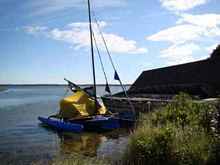 |
Onward tucked in next to the collapsed boat
house. |
Working with Rick on his engine, I got a better sense of his
style of operating and how different it is from my own. I began
to see Rick as an experimenter, a test pilot and a consummate
mechanic. He had to take the carburetor off the engine a number
of times, and I thought he might pull his arm out of his socket
from yanking on the starter cord. Finally, even with the sketchy
gas, he got the motor running. He said it well: “I don’t
quit.” And then, as the day was getting late, he used one
of my inflatable rollers, got his bow up in the air, and, lying
in the shallow water in the swamp grass, patched the screw hole
in the hull that had been leaking. Rick’s style is “just
do it”, and his favorite phrases are, “Not a problem”,
and “It’s a piece of cake.”
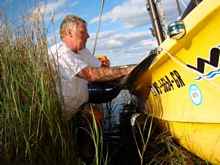 |
Rick fixing the slow leak in his hull. |
I think of myself as an adventurer, but in contrast to Rick I
am really much more conservative. I like to make a plan and have
a backup plan or two. I like to talk options and weigh alternatives.
And even though I just might go my own way, I like to hear lots
of advice from others. I always was asking, “What’s
the plan?” and “Can we talk about this?” I’m
always wondering about what the unintended consequences of any
decision might be. I think all this is my way of creating a sense
of adventure by thinking about what might go wrong, but I also
like the process of discussing and planning and trying to reach
consensus with a group of guys, even though at times that can
be quite maddening.
 |
Mac trying to plan the next step (pic by David). |
Our small cove was sheltered and beautiful, with an old collapsed
boat house and shallow water that made it easy to work on the
boats. The island is almost all nature conservancy land, with
open fields, and is drop dead beautiful. Joe and I both took naps.
David cooked up the best meal of the trip – kielbasa, onions
and potatoes. And we all swapped disaster and near disaster stories.
The wind dropped (finally) just after dark.
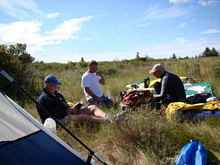 |
Drying out. |
Of course, I did lots of thinking about the real possibility
of swamping (or getting pooped) in big waves. I want to be able
to sail successfully in challenging conditions. The WR 17 can
be pretty tightly buttoned up. Joe and I have full spray skirts
for the rear cockpit and he travels with his hard cover and I
have a soft cover for my front cockpit. We both agreed that the
front windshield was essential and kept the waves coming over
the bow from getting into the boat. The real PFD’s on the
WR are our training wheels, the amas. It was clear from Rick’s
experience that the boat won’t sink as long as the amas
don’t fill. I remember Jim Brown once suggesting that the
amas of his Searunners should be filled with empty plastic milk
jugs. I have been carrying my hand bilge pump in an ama, and I
am definitely going to move it to the main hull. If the boat is
full of water in big waves the last thing I want to do is open
the hatch in the ama and go fishing for the pump. And I am going
to add a good hand bailer as well.
And what about flotation? I wanted more storage space under the
floor in the main hull, but have been unwilling to jettison the
three shaped foam blocks – each one about 8 inches thick
- that support the 2007 WR hard floor. I do have two hatches to
access the limited space between the blocks. Of course, underway
flotation inside the hull has no effect on freeboard, but if the
main hull does fill with water, the flotation will limit the amount
of water inside the boat, and if the waves are not too big, should
provide enough freeboard to allow me to pump the water out. I’m
thinking about adding additional flotation to any unused spaces
under the floorboards.
And what about weight? We do have a lot of volume in and on top
of our WR’s that we can fill with stuff for beach cruising,
but what are the trade-offs as we add weight, decrease freeboard
and maybe get bow or stern heavy? For racing, Joe, the sly old
fox, carries four gallons of water under his floor forward on
a pulley system that he can move forward and aft to adjust his
trim. Every time I add one more “essential” piece
of gear to my boat, I do add weight. I try to use backpacking
camping gear if possible. And yet my boat rides 1-2 inches lower
in the water than Joe’s. Am I guilty of gear gluttony, or
is my 2007 with its increased beam and heavier floor to blame
– or maybe both?
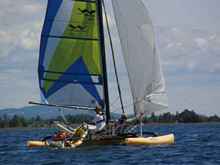 |
Off to the La Cloche Channel. |
And finally what about securing and protecting gear? When Rick’s
boat filled with water, gear began to float around – some
headed out of the boat. David’s cell phone and camera were
waterlogged. David said that the floating floorboards were a real
nuisance. So in the event of swamping, ease of movement on and
in the boat, being able to find essential gear, and keeping stuff
from floating away, all become important.
DAY FOUR: We started out under blue skies with
a light breeze from the west that became moderate as the day progressed.
Rick had a special adventure planned for the day. Most of the
people we talked to didn’t even know our plan was possible
in a sailboat. We were heading west and then north around Little
La Cloche Island, up the Boat Passage, past Dreamer’s Rock
into a small bay just south of the causeway that connects Manitoulin
Island to the mainland. Rick’s idea was to drop our masts
on the water. I had never done that before. “Piece of cake”,
said Rick, and he was right. And then motor through a set of cement
box culverts under the highway and an abandoned rail line and
into the La Cloche Channel. This would let us into the northeastern
quarter of the North Channel – the Bay of Islands - through
the back door, an area considered a dead end by most cruising
sailors. We passed through the culverts – another “piece
of cake” as promised – and under the power lines.
We raised our masts in a shallow cove (David joined me on Onward)
and we were off with the wind on our beam.
 |
Another “piece of cake” (pic by
David). |
We looked into Jumbo Bay for a camping spot, but continued north.
We rounded the northeast corner of Great La Cloche Island and
entered the magical Bay of Islands, a riot of small islands with
underlying rounded rocks, jumbles of boulders and sparse vegetation.
Rick found us a cove with 360 degree protection and a small spot
for a tent. At 4 AM there was a rumble of thunder, and just as
Joe said, “I think the storm is passing us by”, the
skies opened up with a deluge. It was the first real test for
my on-board MSR Mutha Hubba tent, and felt a smug satisfaction
as I stayed dry as a bone. Rick and David were using cots that
kept them a few inches off the ground, a great choice for camping
ashore in this knobby terrain.
 |
Tucked in a cove in the Bay of Islands (pic
by David). |
DAY FIVE: The rain continued all morning. As
the skies began to clear, we headed west in a light south wind.
We were more than 35 miles due east of Spanish, and Joe needed
to be on the road by the end of the next day. Rick had to squirt
gas in his carb to get his 2 stroke Johnson fired up, but it would
mostly keep running when it got warmed up. Bruce Matlack swears
that 2 strokes are the way to go – after spending too many
hours swearing at his old 4 stroke Honda. He claims that 2 strokes
are much less finicky, will run on bad gas, and overall are more
reliable. But I love my little air cooled Honda. My mechanic reminds
me that gas today has “the shelf life of a loaf of bread”.
The only time my engine has let me down was when I put old gas
in it on the OBX 130. I had to take off the carb and clean out
the jet, and borrow good gas to get it running again. Before this
trip I replaced the carb and carry the old one as a spare. After
every trip, I pump out the gas from the outboard tank and put
it in my car.
We sailed in light and dying winds. We found a great camping
spot in the cove between Kirkpatrick and Perley Islands. Joe and
I sailed in from the north. Rick had been out scouting to the
south of the islands and we were able to pull his boat thru the
cove’s south entrance thru 8 inches of water over the mud
clay bottom thanks to his shallow draft. The mud in the cove had
a laugh on me when I threw out my stern anchor in the shallow
water. I gave a mighty heave. The mud held my feet like glue and
I followed the anchor face first into the water. I had to struggle
to regain my feet and splash back to the boat. It was a beautiful
still night. Joe unloaded one of his MRE’s on me, my first.
We lay on the rocks and talked and watched the stars.
 |
Onward tucked in between the two islands (pic
by Joe). |
DAY SIX: Joe and I didn’t have enough
gas between us to make it all the way back to Spanish, about 20
miles to the west. We agreed that as soon as the fog lifted in
the morning and the wind filled in, we would all shove off. We
got a great light breeze from the west and by 9 AM we were underway.
By the time the breeze died we were close enough to Little Detroit,
the gateway to the Spanish River, to fire up our engines. The
sun was hot and I was able to use my tiller steering to lie out
my starboard tramp in the shade of the main and stay on course.
My only concern was that I just might fall asleep.
|
The view from the campsite (pic by David) |
I could have stayed out another 2 days, but the prediction was
for light winds and my belly was full of adventure. The take out
at the launch ramp went well. And the hot shower at the marina
was divine. I was finally able to check in with Darla after being
out of contact for 10 days. Joe took us all out to dinner at the
local diner, we took a group photo, and Joe and I hit the road
in different directions. Rick and David planned to head out for
another adventure.
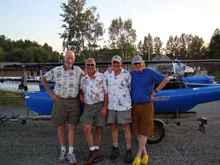 |
Joe, Rick, David and Mac |
So how did we do sailing “in company”? Coordinating
plans, sailing together, trying to meld different styles all have
their advantages and disadvantages. Any one of us could have sailed
alone and had a great adventure, I am sure. But it was great to
sail together, to use each other to reality check, to compare
notes, and, when the chips were down, to provide mutual aid. Joe
needed Rick’s supplies to repair his bilge pump. Rick benefited
from my towing and then some of my gear to get going again. I
never would have attempted the secret pass under the box culverts
without Rick’s encouragement. And hey, we built a special
camaraderie on our adventure together. We share some memories
that are unique to us as a team, memories that are woven together
with our love for these amazing boats.
I am already making plans to come back next summer. We hadn’t
even begun to explore the heart of the North Channel islands,
including the Benjamins, the crown jewels. We had chosen to sail
in the main channel with big winds and waves, but we could have
easily stayed to the north half of the channel in more protected
water. We had covered a lot of ground – maybe 100 miles
in five days of sailing. Next time I want explore more, scoot
around and discover the protected coves and the beaches where
the big boats fear to tread. I had my first date with the North
Channel. She was tempestuous and beautiful and knew how to kick
up her heels. I now wanted to snuggle up with her on the couch
and get her to reveal some of her secrets. And also we can go
out and dance and have a wild time when the spirits move us.
“I have sailed throughout the
west coast of Florida.
I’ve sailed throughout the Virgin Islands.
A good part of most of the Great Lakes. North Carolina and the
Outer Banks. Coast of California. Coast of Alaska.
And I’ve never see anything as beautiful as this.
Absolutely fantastic. Great sailing.” - Joe
The End
*****

|

